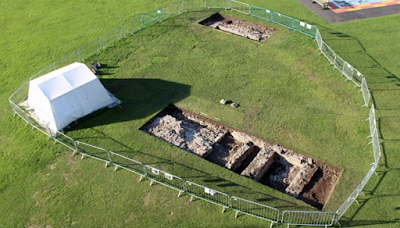I attended a talk by archaeologist James Meek in Pembroke, where he outlined the exploratory excavations within the walls of Pembroke Castle. The intriguing outline of a large building was revealed by parch marks during the summer of 2013.
The outline of a possible late medieval double-winged hall house was confirmed by geophysical surveys carried out by Dyfed Archaeological Trust, funded by the Castle Studies Trust, in 2016. If these remains prove to be a ‘mansion-house’ and are dateable to the fifteenth century, this could be a compelling candidate for the location of King Henry VII’s birth in 1457.
Visitors to the castle are currently treated to a 'tableau' of Henry's birth in the adjacent Henry VII tower, although Margaret Beaufort looks much older than fourteen - and her lady in waiting can hardly hold the heavy child! I've always thought the room too small and more likely to be used as a guardroom than living accommodation.
The tower was recorded as being in a poor state of repair at that time, so an adjacent building could have been commissioned by Jasper Tudor, the uncle of Henry, who was granted the castle in 1452 when he was made Earl of Pembroke. Jasper didn't live in the castle until the death of his brother Edmund in 1456, his sister-in-law Margaret Beaufort came in to his care and gave birth to Henry Tudor the following year.
Two trial trenches were excavated to establish the condition, character and extent of the building – and, if possible, its date. The archaeological evidence uncovered was partly compromised by excavations of the site in 1931, which were unrecorded apart from two black and white photographs.
 |
| 1931 excavations |
The 2018 evaluation confirmed the presence of the large free standing stone structure within the Outer Ward, the remains of which indicate it was domestic and of high status. A curving staircase with two spiral steps were exposed and finds indicate that the roof was of slate with green glazed ceramic ridge tiles.
 |
| 2018 excavation |
A large cess pit was excavated with finds including pottery of medieval and later date, animal bone, including swans and blackbirds, and a significant number of oyster shells. Finds also included a few sherds of Roman pottery.
Archaeologist James Meek said it was not yet possible to date the building to the time of Henry Tudor's birth, but the two preliminary trenches strengthen the case for excavation of the rest of the site later this year - so watch this space.
Tony Riches



No comments:
Post a Comment
Thank you for commenting